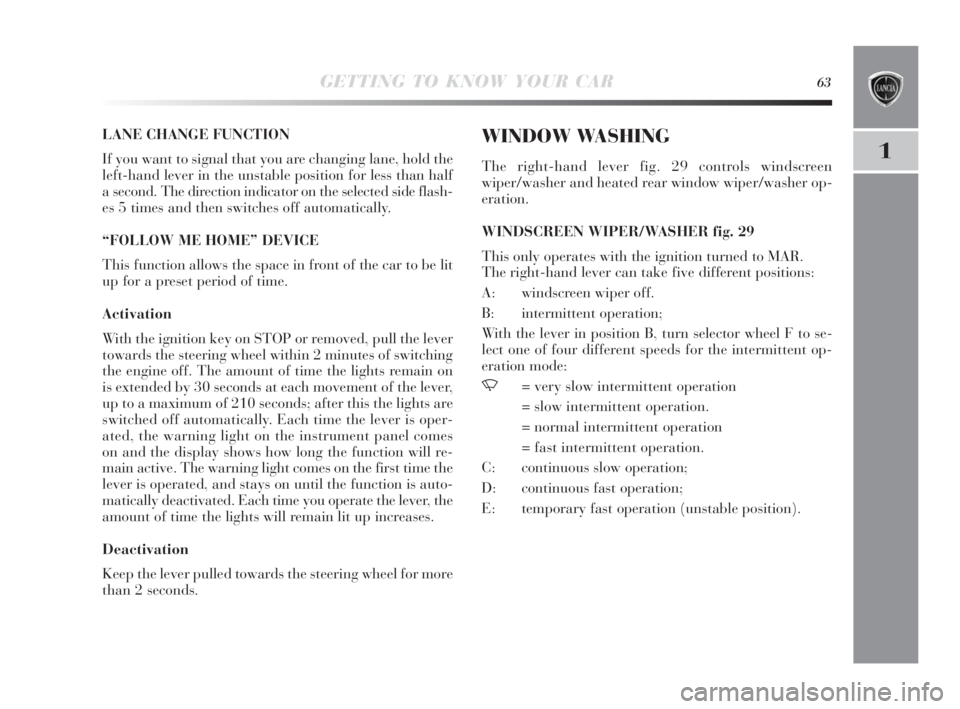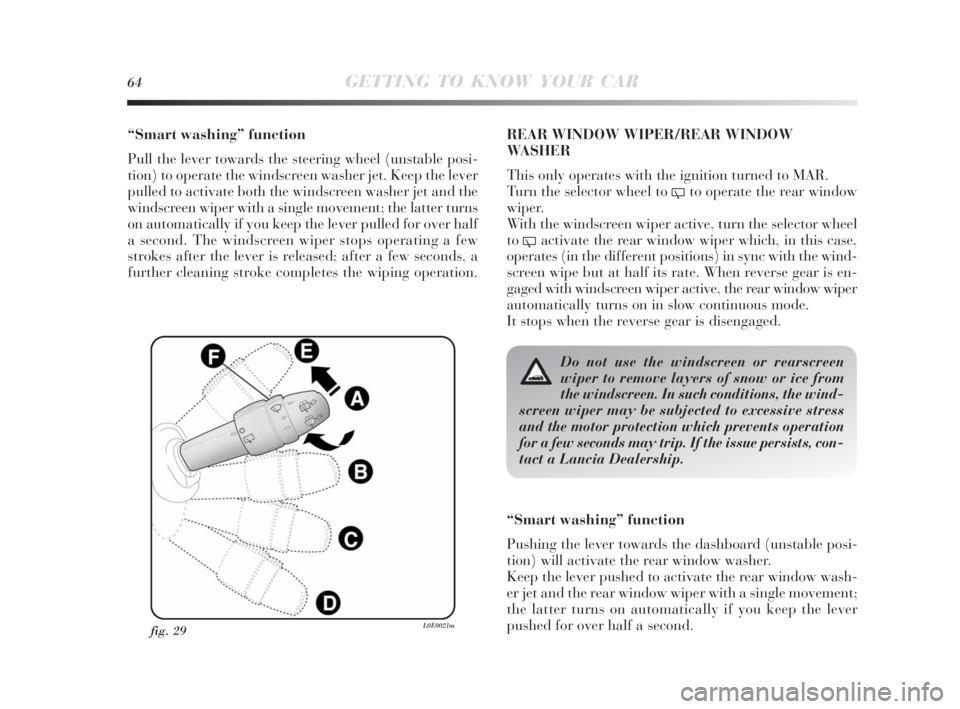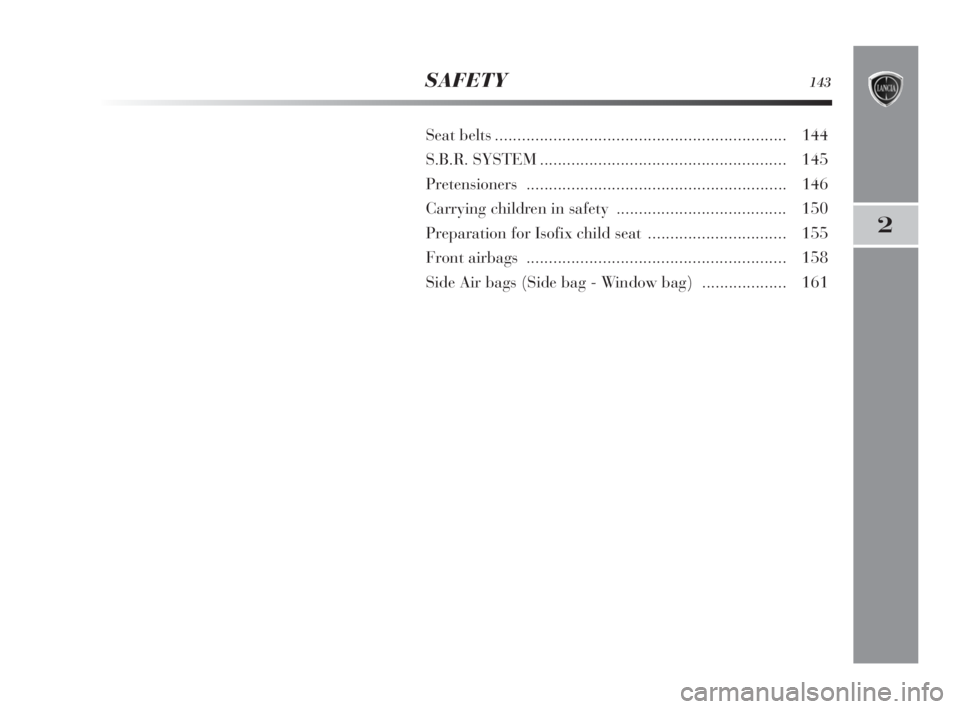window Lancia Delta 2010 Owner handbook (in English)
[x] Cancel search | Manufacturer: LANCIA, Model Year: 2010, Model line: Delta, Model: Lancia Delta 2010Pages: 276, PDF Size: 5.31 MB
Page 64 of 276

GETTING TO KNOW YOUR CAR63
1
LANE CHANGE FUNCTION
If you want to signal that you are changing lane, hold the
left-hand lever in the unstable position for less than half
a second. The direction indicator on the selected side flash-
es 5 times and then switches off automatically.
“FOLLOW ME HOME” DEVICE
This function allows the space in front of the car to be lit
up for a preset period of time.
Activation
With the ignition key on STOP or removed, pull the lever
towards the steering wheel within 2 minutes of switching
the engine off. The amount of time the lights remain on
is extended by 30 seconds at each movement of the lever,
up to a maximum of 210 seconds; after this the lights are
switched off automatically. Each time the lever is oper-
ated, the warning light on the instrument panel comes
on and the display shows how long the function will re-
main active. The warning light comes on the first time the
lever is operated, and stays on until the function is auto-
matically deactivated. Each time you operate the lever, the
amount of time the lights will remain lit up increases.
Deactivation
Keep the lever pulled towards the steering wheel for more
than 2 seconds.WINDOW WASHING
The right-hand lever fig. 29 controls windscreen
wiper/washer and heated rear window wiper/washer op-
eration.
WINDSCREEN WIPER/WASHER fig. 29
This only operates with the ignition turned to MAR.
The right-hand lever can take five different positions:
A: windscreen wiper off.
B: intermittent operation;
With the lever in position B, turn selector wheel F to se-
lect one of four different speeds for the intermittent op-
eration mode:
,= very slow intermittent operation
= slow intermittent operation.
= normal intermittent operation
= fast intermittent operation.
C: continuous slow operation;
D: continuous fast operation;
E: temporary fast operation (unstable position).
001-142 Delta 3ed gb 30-11-2009 11:22 Pagina 63
Page 65 of 276

64GETTING TO KNOW YOUR CAR
“Smart washing” function
Pull the lever towards the steering wheel (unstable posi-
tion) to operate the windscreen washer jet. Keep the lever
pulled to activate both the windscreen washer jet and the
windscreen wiper with a single movement; the latter turns
on automatically if you keep the lever pulled for over half
a second. The windscreen wiper stops operating a few
strokes after the lever is released; after a few seconds, a
further cleaning stroke completes the wiping operation.
fig. 29L0E0021m
REAR WINDOW WIPER/REAR WINDOW
WASHER
This only operates with the ignition turned to MAR.
Turn the selector wheel to
'to operate the rear window
wiper.
With the windscreen wiper active, turn the selector wheel
to
'activate the rear window wiper which, in this case,
operates (in the different positions) in sync with the wind-
screen wipe but at half its rate. When reverse gear is en-
gaged with windscreen wiper active, the rear window wiper
automatically turns on in slow continuous mode.
It stops when the reverse gear is disengaged.
Do not use the windscreen or rearscreen
wiper to remove layers of snow or ice from
the windscreen. In such conditions, the wind-
screen wiper may be subjected to excessive stress
and the motor protection which prevents operation
for a few seconds may trip. If the issue persists, con-
tact a Lancia Dealership.
“Smart washing” function
Pushing the lever towards the dashboard (unstable posi-
tion) will activate the rear window washer.
Keep the lever pushed to activate the rear window wash-
er jet and the rear window wiper with a single movement;
the latter turns on automatically if you keep the lever
pushed for over half a second.
001-142 Delta 3ed gb 30-11-2009 11:22 Pagina 64
Page 66 of 276

GETTING TO KNOW YOUR CAR65
1
fig. 30L0E0023m
The rear window wiper stops operating a few strokes af-
ter the lever is released; after a few seconds, a further
cleaning stroke completes the wiping operation.
RAIN SENSOR
(for versions/markets, where provided)
The rain sensor A-fig. 30 is located behind the interior
rear-view mirror in contact with the windscreen and au-
tomatically adjusts the frequency of the windscreen wiper
strokes according to the rain intensity during intermittent
operation.
The sensor has an adjustment range that varies progres-
sively from wiper still (no stroke) when the windscreen
is dry, to wiper at first continuous speed (slow continu-
ous operation) with intense rain.Activation
Move the right lever down by one click.
The activation of the rain sensor is signalled by a com-
mand acquisition stroke.
IMPORTANT Keep the glass in the sensor area clean.
By turning selector wheel F-fig. 29 is it possible to increase
the sensitivity of the rain sensor to obtain a more rapid
variation between wiper still (no stroke) when the wind-
screen is dry, to wiper at first continuous speed (slow con-
tinuous operation).
The increase in the sensitivity of the rain sensor is signalled
by a control and acquisition “stroke”.
When the windscreen washer is operated with the rain sen-
sor activated, the normal washing cycle is performed, at
the end of which the rain sensor resumes its normal au-
tomatic function.
001-142 Delta 3ed gb 30-11-2009 11:22 Pagina 65
Page 86 of 276

GETTING TO KNOW YOUR CAR85
1
IMPORTANT If the battery is disconnected or the pro-
tection fuse blows, the door opening/closing mechanism
must be reinitialised as follows:
❍close all the doors;
❍press button
Áon the key or door locking/unlocking
button
≈on the dashboard;
❍press button
Ëon the key or door locking/unlocking
button
≈on the dashboard.
If the child lock was engaged and the previ-
ously described locking procedure carried
out, operating the internal handle will not
open the door but will only realign the door lock
knob. To open the door, the outside handle must be
used. The door central locking/unlocking button
≈is not disabled by the engagement of the emer-
gency lock.
ELECTRIC WINDOWS
These operate when the ignition key is turned to MAR and
for about 2 minutes after turning the key to STOP or re-
moving it.
The control buttons are located in the door panels (the
driver-side door panel can be used to operate all the win-
dows).
There is may be anti-crush safety device which starts
working when the front windows are closing.
CONTROLS fig. 54
A. opening/closing left-hand front window; “continuous
automatic” operation during window opening/closing
stage;
B. opening/closing right-hand front window; continu-
ous automatic operation during window open-
ing/closing stage;
C. enabling/disabling of rear door electric window con-
trols;
D. opening/closing left-hand rear window (for ver-
sions/markets, where provided); continuous automat-
ic operation during window opening/closing stage;
E. opening/closing right-hand rear window (for ver-
sions/markets, where provided); “continuous auto-
matic” operation during window opening/closing stage.
001-142 Delta 3ed gb 30-11-2009 11:22 Pagina 85
Page 87 of 276

86GETTING TO KNOW YOUR CAR
Press the buttons to open/close the required window.
When one of the two buttons is pressed briefly the win-
dow travel takes place in stages; if the button is held
down, continuous automatic operation is activated both
for closing and opening. . If the button is pressed once
again the window will stop in its current position.
Holding the button pressed for a few seconds will auto-
matically raise or lower the window (only with key on
MAR).
Incorrect use of the electric windows may be
dangerous. Before and during operation en-
sure that passengers are not at risk from the
moving glass, either directly or through personal
objects getting caught in the mechanism.
Always remove the ignition key when leav-
ing the car to prevent the electric windows be-
ing operated accidentally and constituting a
danger to the passengers in the car.
Passenger-side front door/rear doors
On the passenger-side front door control panel, and on
some versions also on the rear doors, buttons F-fig. 54 are
provided to control the associated windows
fig. 54L0E0045m
001-142 Delta 3ed gb 30-11-2009 11:22 Pagina 86
Page 88 of 276

GETTING TO KNOW YOUR CAR87
1
Anti-pinch safety device
The vehicle is equipped with an anti-pinch safety device
for the upwards motion of the windows.
This safety system is capable of recognizing the presence
of an obstacle whilst the window is closing; when this hap-
pens, the system stops the travel of the glass and, de-
pending on the position of the window, reverses its move-
ment.
This device is also useful when the windows are activat-
ed accidentally by children on board the vehicle.
The anti-pinch function is active both during manual and
automatic operation of the electric windows. Following
the intervention of the anti-pinch system, the window trav-
el is immediately interrupted and subsequently reversed
until the lower end of travel is reached. During this time
the window cannot be operated in any way.IMPORTANT If the anti-pinch protection intervenes 5
times consecutively within 1 minute or a system failure
is detected, the automatic window closing function is in-
hibited. The window can then only be operated in steps of
half a second and the button must be released following
each step.
One of the following manoeuvres must be carried out in
order to restore correct operation:
❍switch off and restart the engine;
❍fully lower the window concerned.
IMPORTANT With ignition key at STOP or removed, the
electric windows remain active for about 3 minutes and
are deactivated the moment a door is opened.
001-142 Delta 3ed gb 30-11-2009 11:22 Pagina 87
Page 89 of 276

88GETTING TO KNOW YOUR CAR
Electric window system initialisation
The safety system must be re-initialised after disconnect-
ing the battery or if the relevant protection fuse is blown.
Initialisation procedure:
❍fully close the window to be initialised manually;
❍after the window has reached the upper end of travel,
hold the up button pressed for at least one second.
IMPORTANT Where provided, following the disconnec-
tion of the power supply (replacing or disconnecting the
battery or replacing the protection fuse for the electric win-
dows control units), the automatic setting for the electric
windows must be reset.The reset operation should be carried out with the doors
closed according to the following procedure:
1. completely lower the driver-side window and keep the
button pressed for at least 3 seconds once the end of
travel position has been reached;
2. completely raise the driver-side window and keep the
button pressed for at least 3 seconds once the end of
travel position has been reached;
3. repeat stages 1 and 2 for the passenger-side window
4. check that the initialisation has taken place correctly
by checking the automatic operation of the windows.
IMPORTANT With central locking on, operating the in-
ternal handle of one of the doors will unlock all the doors.
If there is no power (blown fuse, battery disconnected,
etc.) the doors can still be locked manually. As in this case
the automatic window opening function is not available,
to open or close the door with the window closed, apply
pressure to the window towards the vehicle interior, to aid
the passage of the window against the trim.
001-142 Delta 3ed gb 30-11-2009 11:22 Pagina 88
Page 106 of 276

GETTING TO KNOW YOUR CAR105
1
On the 1.4 Turbo Jet 150 HP version, when the SPORT
button is pressed, the turbocharger (overboost) function
is also activated; the engine management control unit, de-
pending on the
position of the accelerator pedal and, for a limited time,
allows maximum pressure leves inside the turbocharger
to be reached with a consequent increase in engine torque
compared with that that can be reached normally.
This function is particularly useful if maximum perfor-
mance is required for a short period (e.g. when overtak-
ing).
IMPORTANT When the SPORT function is used, during
acceleration shuddering of the steering may be noticed
which is typical of a sports setting.
IMPORTANT The function is activated about 5 seconds
after the SPORT button is pressed.
System failure
In the case of fault, the system notifies the driver by means
of a message on the reconfigurable multifunctional display
instrument panel and by lighting up the amber symbol
i.
In this case, go to a Lancia Dealership.
DRIVING ADVISOR
(for versions/markets, where provided)
The Driving Advisor is a warning system that notifies
the driver if they drift out of their lane because they have
been distracted.
A video sensor, fitted to the windscreen near the internal
rear-view mirror, detects the lane boundaries and the ve-
hicle’s position in respect to them.
IMPORTANT If the windscreen needs replacing on cars
fitted with a Driving Advisor system, it is advisable to go
to a Lancia Dealership. If the repair is being carried out
at a specialist window replacement centre, it is still nec-
essary to go to a Lancia Dealership to have the tv cam-
era calibrated.
001-142 Delta 3ed gb 30-11-2009 11:22 Pagina 105
Page 144 of 276

SAFETY143
2
Seat belts ................................................................. 144
S.B.R. SYSTEM....................................................... 145
Pretensioners .......................................................... 146
Carrying children in safety ...................................... 150
Preparation for Isofix child seat ............................... 155
Front airbags.......................................................... 158
Side Air bags (Side bag - Window bag) ................... 161
143-164 Delta 4ed gb 12-02-2010 10:20 Pagina 143
Page 159 of 276

158SAFETY
FRONT AIRBAGS
The car is provided with front air bags for the driver and
the passenger, driver’s knee air bag (for versions/markets,
where provided) and front side bags (side bags - window
bags).
The front airbags (driver’s, passenger’s, driver’s knee air
bags) have been designed to protect the occupants in the
event of head-on crashes of medium-high severity, by plac-
ing a cushion between the occupant and the steering wheel
or dashboard.
Front air bags are designed to protect car’s occupants in
head-on crashes and therefore non-activation in other
types of collisions (side collisions, rear shunts, roll-overs,
etc.) is not a system malfunction.
An electronic control unit causes the bag to inflate in the
event of a head-on crash.
The bag will inflate instantaneously placing itself between
the front occupant’s body and the structures which could
cause injury. It will deflate immediately afterwards.
The front airbags (driver’s, passenger’s, driver’s knee air
bags) do not replace but rather complement the seat belts,
which you are always recommended to wear, as specified
by law in Europe and most non-European countries.
In the event of a collision, a person not wearing a seat belt
may be thrown forward and come into contact with the
bag before it has fully opened. The protection offered by
the bag is reduced in such a case.The front airbags may not be activated in the following sit-
uations:
❍in collisions against highly deformable objects not af-
fecting the front surface of the car (e.g. bumper colli-
sion against guard rail, etc.);
❍car penetration under other vehicles or protective bar-
riers (e.g. trucks or guard rails);
in these instances they would not provide any additional
protection compared with the seat belts, so their deploy-
ment would be improper. Non deployment in such cases
does not constitute a fault.
Do not apply stickers or other objects to the
steering wheel, the dashboard in the passen-
ger-side airbag area, the roof side upholstery
or the seats. Do not place objects (e.g. cell phones)
on the passenger-side dashboard because these
could interfere with the correct opening of the airbag
and cause severe injury to occupants.
143-164 Delta 4ed gb 12-02-2010 10:20 Pagina 158